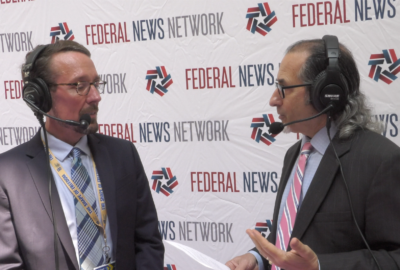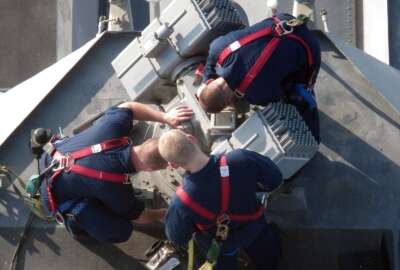Hubbard Radio Washington DC, LLC. All rights reserved. This website is not intended for users located within the European Economic Area.
Navy’s digital warfare office focused on closing capability gaps, building requirements
The Navy, along with the other armed forces, has been working to modernize its data and communications networks under a DoD plan known as the Joint All-Domain C...
Best listening experience is on Chrome, Firefox or Safari. Subscribe to Federal Drive’s daily audio interviews on Apple Podcasts or PodcastOne.
The Navy, along with the other armed forces, has been working to modernize its data and communications networks under a DoD plan known as the Joint All-Domain Command and Control System. The Navy’s part of JADC2 is a project called Project Overmatch. It’s actually further along in development than JADC2 itself. For a progress report, at the SeaAirSpace conference, Federal Drive with Tom Temin caught up with the acting director of the Navy’s digital warfare office, Kelly McCool.
Interview transcript:
Tom Temin: Well, let’s begin at the beginning. Just review the current priorities of the digital warfare office — a little bit about the mission and what you’re looking at for 2022.
Kelly McCool: Absolutely. So the digital warfare office is really focused on two general priorities — really going after capability gaps — closing capability gaps, and building the right resourcing and requirements strategies to really align our people and our money to those priorities. And specifically, Project Overmatch is our number one priority in that area. So, I am the resource sponsor for Project Overmatch. And Doug Small is the project manager who’s leading the effort in terms of the acquisition team. What I’m really focused on is making sure we have an enduring, sustaining funding and priorities set as we grow the overmatch project from what it is today into an enduring capability in the future.
Tom Temin: Right. And it’s not at the acquisition stage yet is it?
Kelly McCool: We are in the middle of software development. And so it is in the acquisition stage. What we’ve done is taken the capabilities that exist right now, and we’re really focusing them and growing them. And if you like, I can talk a little more specifically about what that is.
Tom Temin: Yeah, let’s talk about that first. And then we’ll talk about how that’s going to fit into JADC2. But let’s talk about what current status of [Project] Overmatch is.
Kelly McCool: So [Project] Overmatch — the Navy has been focused on the Pacific for quite some time now, and one of the things I’ve really gained an appreciation for is how distributed our forces is gonna be, and how far forward operating and contested areas. And with that comes a new reliance on our networking capabilities. So we really need to modernize our networking capabilities so that like our phones, we can move information from point A to point B without caring how it got there. Or we can move across WiFi zones and cell phone towers, and it’s all transparent to us. We need that kind of capability within our warfighting networks. And then in addition to that, as our force is much more distributed, we need the right decision support tools that will help the warfighter make machine speed decisions really quickly. So that’s another key focus for Project Overmatch.
Tom Temin: And I imagine going with that as a huge focus on cybersecurity, because that’s easy to do than, well, not easy, but you can move networks to networks, protecting that information and those decisions. That’s what makes it all happen.
Kelly McCool: Right, right. So really, the networks and the decision support tools are the foundation of the Naval Operational Architecture [NOA]. And that’s what we’re focused on delivering. And that’s really Project Overmatch’s focus, and Doug Small’s focus is developing that capability as I build the right resourcing and requirements plans.
Tom Temin: And as you build all of those pieces, how do you make sure that it’s going to be interoperable in the future with JADC2, which is still, a lot of concept going on there?
Kelly McCool: Right, absolutely. So JADC2 is at the concept phase. So there’s a strategy that’s been released — there’s a joint warfighting concept for fires and for information advantage, and there’s a lot to tackle there with the joint force and then looking at the strategic global sensors, and trying to make decisions about how you move data around and get it to our forces quickly. So it’s such a broad problem with many facets. You have to pick a place to start, and where the Navy has chosen to start is really focused on our tactical units, and better connecting our tactical units — our aviation systems, our subs and our ships together — in a way where we can operate at the edge. And as JADC2 evolves and refines, we will make sure that we’re connected and we’re aligned there. I should also say I’m the JADC2 rep for the Navy on the CFT — the JADC2-CFT. So with that in mind, I have strong collaboration with the JADC2 members, which includes other service members. And so we are often collaborating on where are those good opportunities to make sure we can connect and not make decisions that prevent us from connecting in the future.
Tom Temin: And from a practical standpoint, how do you think about bandwidth out where they’re in the ocean, and you’re not going to be in Verizon’s 5G territory?
Kelly McCool: Right. So, you’re right. So are shipboard networks, especially when you’re operating in contested spaces, is very limited in bandwidth, and so we have to be smart about the data that we’re moving around, and we have to be able to adjust. And so we need that network of network management where we can manage our spectrum. We can also manage our bandwidth. And we only send the essential data that we have to send. And then backhaul it when we have the connectivity that is maximum, then we can leverage that. But we are designing it upfront for the low bandwidth situations. But being able to more rapidly and adaptively connect and disconnect from our network.
Tom Temin: That’s not a bad way to program — to be kind of economical in what you think you have to ship around for data, it kind of takes you back to the old days. And then a related operational question is the installation of these capabilities on the various ships, because that’s not a trivial issue for the Navy to update every ship with software. And then you’ve got the different limiting capabilities — electricity, bandwidth — on the vessels themselves to think about.
Kelly McCool: Right. So as you know, the Project Overmatch CNO has said it is the number one development priority for the Navy. And, we are to deliver that Naval Operational Architecture by the middle of the decade. So we’re in ’21 right now. It is not too early to think about how we install our hardware, and how we deliver our software too. So, from a hardware standpoint, we have dedicated teams that are focused on that right now. When you think about ships, there are only certain windows of opportunity when they’re in port, where we can do the upgrades that we need to the hardware. And so we track that, and we’re making sure our development effort is aligned there. And similarly with the software, we have to target software delivery by the time the fleet is doing their training. Prior to deployment and leading up to the deployment, we have to have the software and at that point. Nirvana though, is we don’t stop doing the software development, we can do over the air software development when it’s feasible, and the bandwidth allows.
Tom Temin: So you can turn that carrier into a Tesla-like vehicle.
Kelly McCool: That’s North Star right there.
Tom Temin: Alright. And in that programming stage that you described, is that being done by Navy coders, or contractors, or a combination?
Kelly McCool: Yeah, so it’s a strong combination of government and industry partners. So, I would say one of the things since we’re focused right now on the shipboard side, the NAVWAR and the POC[…] team has done a really great job of developing this [Project] Overmatch software factory. So it’s a modern software development factory — it’s really foundational to how we’re going to deliver our capabilities in the future. So think about DevSecOps, and Agile software delivery, and the ability to develop apps in the cloud. So what this is doing is really lowering the barrier of entry for third party entities to deliver software. So, it can introduce non traditional partners — non traditional industry members that can really help us with app development. So, right now, we’re really focused on basic apps. Where we can do math, we’re doing math, but as we grow, this is gonna allow us to scale and I think there’s some huge opportunities for government industry partnership, and especially in the non traditional areas.
Tom Temin: Kelly McCool is acting director of the Navy’s digital warfare office. I spoke with her at this week’s SeaAirSpace conference sponsored by the Navy League.
Copyright © 2024 Federal News Network. All rights reserved. This website is not intended for users located within the European Economic Area.
Tom Temin
Tom Temin is host of the Federal Drive and has been providing insight on federal technology and management issues for more than 30 years.
Follow @tteminWFED





